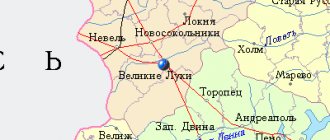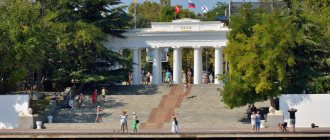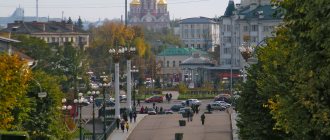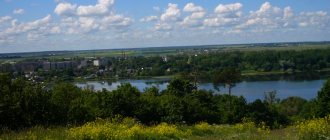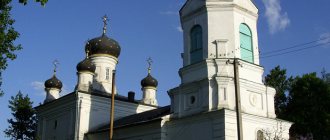The city of Velikiye Luki turned out to be very ancient, because the date of its foundation is considered to be 1166, as evidenced by numerous photos and attractions that have been attracting visitors for decades. This ordinary provincial city has something to please, because it has a great history, and besides, in ancient times it was called the “atrium of Moscow.”
Today I’ll tell you about what’s worth seeing in Velikiye Luki and where to spend a family vacation.
Holy Ascension Cathedral
The construction of this monastery was approved in 1675 by the Novgorod Metropolitan. Previously, the Elias Monastery was located on this site. The modern appearance of the temple is quite modest, but the structure and surrounding area significantly enliven the landscape of the city.
After the revolution, the church was closed, and in the post-war years the building was partially dismantled. The restoration took place only in 1990, and the first service took place only in 1992.
Cathedrals and architectural monuments
The war caused irreparable damage to the city, and there are practically no architectural monuments left here. The main part of the buildings are buildings in the Stalinist Empire style.
Church of the Kazan Icon of the Mother of God
Address: Pushkinskaya st., 2 Telephone: Website: https://luki-eparhia.ru/index.html Opening hours: Daily: 08.00-19.00. Lunch: 12.00-13.00
Built in 1821 in Baroque style. The appearance of the church has not undergone any changes. The bell tower still delights parishioners today. The church has fully preserved the iconostasis. Of the three altars - the Apostles Peter and Paul, All Saints, and the Kazan Mother of God - only the last two have survived.
The church is located in an ancient cemetery dating back to 1803, which is the burial place of famous people of the city, for example, Lieutenant General Tyrtov, nun Palladia, and merchant Chudov.
Holy Ascension Cathedral
Address: Uritskogo st., 4. st. K. Liebknechta, 5 - parish Telephone: 8 (81153) 3-63-39 Website: https://luki-eparhia.ru/index.html Opening hours: Daily: 08.00-19.00. Lunch: 12.00-13.00
Built on the site of the Ilyinsky Monastery, which was burned during the Time of Troubles. The church, rebuilt in the Baroque style in the 18th century, was called Peter and Paul and belonged to the Ascension Convent.
In Soviet times, the temple was brought into a “non-cult form” and only at the end of the 20th century was it restored and re-consecrated.
Particularly significant shrines and relics:
- Icon "Joy of All Who Sorrow"
- Icon of St. Tikhon
- Icon of St. Martyria of Zelenetsky
- Particles of saints' relics
Remains of the foundation of the Catholic Church of St. Anthony of Padua and the Name of the Venerable Virgin Mary
Address: Parkovaya st.
In 1904, after much petition and construction, the Catholic Church in Velikiye Luki was consecrated and opened its doors. In 1928, the temple community transferred the spiritual building to the city club.
The damaged church was dismantled into bricks after the liberation of the city in 1943. Today, the foundation, basement and some fragments of the walls have been preserved.
Velikoluksky Drama Theater
The Drama Theater is a large cultural institution and is housed in a building that was built in the post-war years and designed in the style of late classicism. During the Second World War the theater was closed and then moved to a new building. Only in 1994 the building was repaired.
The theater's repertoire includes productions of various genres, including:
- comedies;
- dramas;
- one-man performances.
The theater's attendance is about 20 thousand people a year. It is worth noting that the Drama Theater is located in a place from where you can get to any part of the city. That is why meetings are often scheduled here.
Velikolukskaya Fortress
Velikiye Luki, whose attractions are post-war monuments, is a city in which fierce battles took place not only during the Great Patriotic War. One of the interesting places is a fortress built several centuries ago.
The fortress is one of the most visited attractions in the city. And this is connected not only with its historical value, but also with its location. Since 1198, the fortress was burned and rebuilt several times. Gradually the fortifications became more advanced, since from a military point of view the place was very successful for defense.
The last battle that the fortress saw took place in 1953. Bunkers were installed in it and trenches were dug, and all buildings were completely destroyed. In the post-war period they were not restored, but trees were planted on the ramparts.
Since then, the church has been a small park, attracting city guests and tourists not only in the summer, but also in the winter, when the slopes are used for snow skiing.
In 2014, the fortress gates were restored to their original appearance, and wooden paths appeared on the ramparts. On the fortress there is a T-34 tank, which is installed in memory of the crew that broke into the fortress during the Second World War, as well as all the tank crews who participated in the battles during the war. This monument was erected in 1974. It was this year that the 30th anniversary of the victory in the Second World War was celebrated.
Currently, the T-34 tank is located on a reinforced concrete pedestal in such a way that it seems that it is about to take off. That is why townspeople often call it a flying tank.
It is worth noting that it is from the fortress that hot air balloons take off during the international meeting of balloonists. This spectacle is one of the most beautiful, since after takeoff the balls compete with each other, flying almost above the surface of the water.
When planning to attend this event, it is worth remembering that the city's population almost doubles this week , so it is important to book a hotel room in advance.
A few facts about the Velikolukskaya Fortress:
- The earthen rampart, which has survived to this day, was created in 1704-1708 by decree of Peter 1. At that time, the fortress had 6 bastions in the corners and was equipped with 40 cast-iron cannons.
- After 1709, the fortress ceased to function as defensive buildings.
- Inside the fortress there were 2 temples, barracks, a prison, food warehouses and other buildings. Having visited Velikiye Luki and getting into the fortress, you can now only find tablets that help you understand where these buildings were located.
The total area of the fortress is 11.8 hectares.
Main attractions
The city of Velikiye Luki was unable to preserve its ancient sights. This is due to the history, rich in military events. The settlement has always been a border outpost of the state. Even during the Second World War, the city again had to remember its military past. Therefore, the main attractions are fortifications, obelisks and memorials of military history.
The main places in Velikiye Luki can be seen in 3-4 days in the city.
Velikolukskaya Fortress
Of all the attractions in Velikiye Luki, the oldest is the Velikiye Luki Fortress . Unfortunately, only remains of it remain, but they also give an idea of the scale of the buildings and introduce visitors to the history.
The fortress received its final appearance under Peter I. Until the 17th century, the fortress structures were constantly rebuilt. The fortress was destroyed by the enemy several times, but was later rebuilt. In 1704, Peter I ordered the replacement of wooden buildings with stone ones. But very soon the fortifications lost their significance. In the 20th century, the fortress again became the site of fierce battles.
Today, only the remains of bastions and arched gates remain at this place. The Engineering Bastion is famous for its tank monument. On the pedestal there is a combat vehicle that strives upward. Because of this, the monument received the popular name “Tank Flying into the Sky.”
The central place of the exhibition is given to the north-eastern bastion. On a hill there is an Obelisk of Glory dedicated to the heroes of the Great Patriotic War. From the highest point of the city you can see its surroundings. The complex is reflected in the waters of the river, which creates a unique atmosphere.
Velikolukskaya Fortress is an open-air museum. It is a favorite place for city residents, where you can spend time with the whole family, stroll along the paths and alleys.
It is this place that annually becomes the center of the aeronautics festival . From here there is a mass launch of colorful balloons. It attracts participants and spectators from different places. This spectacle amazes with its beauty, grandeur, and brightness of colors.
Obelisk of Glory
The obelisk was erected on the Velikiye Luki fortress in 1960. Its total length is 26 m, while the length of the 5-pointed star is 3 m. The shaft on which the obelisk is located rises 20 m above the river level, so it can be argued that the structure is located at the highest point of the city.
This obelisk symbolizes the cohesion of the military brotherhood that was able to resist the invaders. It is worth noting that the obelisk is located on the site of a mass grave of soldiers of 26 nationalities.
The obelisk towering over the city is a symbol of the indivisibility of peoples in the struggle for a great victory over fascism. Velikiye Luki received the title of city of military glory in 2008, and before that they were awarded the Order of the Patriotic War, 1st degree. It is worth noting that the city acquired the title “Great” only in 1408, despite the fact that the first mention of Luki appeared in the chronicle in 1166.
The fortress and the surrounding area near the obelisk of glory are one of the most popular places that citizens and city guests choose for walks.
Other interesting places
Walking along the city streets will be no less interesting. The architecture of the city is mainly represented by Soviet buildings, but they also have their own personality and give an idea of the city and its inhabitants. The central streets of the city boast magnificent buildings of Stalinist architecture.
Now the streets are rapidly being renewed and new art objects and small architectural forms are appearing here. One of the popular places among residents and guests of the city are armchairs for lovers. The openwork forged metal chairs located on Lenin Square are already a favorite art object of citizens and tourists.
A great place for relaxing walks is A.S. Pushkin Park. A nice, well-kept park is located in the city center. Here you can relax under the canopy of old trees, stroll along the paths, or relax on a bench. There is a bust of A.S. Pushkin in the park. The park territory is located opposite the Ascension Cathedral on the banks of the Lovat River.
In the city you can find other entertainment besides visiting memorable historical places:
- The Bayazet restaurant is popular among townspeople and tourists. The restaurant is located on the river embankment in the central part of the city. Visitors will enjoy dishes of European and Caucasian cuisine and a magnificent view from the terrace.
- You can visit the Orange cafe with children. It is located in a shopping center with the same name. Children will love the menu with desserts, cakes, pastries, drinks and sandwiches.
- Also a popular place for recreation and entertainment is the entertainment center, where citizens like to come with the whole family. There are restaurants, a gaming area, various halls and slot machines.
- On Lenin Avenue, at the Coffee House establishment, you can take a break from walking and enjoy a good cup of coffee or tea and delicious home-made pastries.
The attractions of the city of Velikiye Luki are good to visit not only in summer, but also in winter, acquiring a special charm. Walking around the outskirts of the city on a frosty day, you can feel the spirit of a real Russian winter.
Museum-Estate of M. P. Mussorgsky
While traveling around Velikoluksky district you can also visit several attractions. One of them is the estate of the great composer.
By visiting the composer’s house, you can immerse yourself in the atmosphere of everyday life of the time in which the great composer lived. Also, thanks to a tour of the museum, you can imagine the life of peasants in the 19th century. The building is located on the shore of Lake Zizhitsky.
Estate of S. Kovalevskaya
An architectural monument in the pseudo-Gothic style of the 19th century attracts a large number of tourists to the village of Polibino near Velikie Luki, because in its building there is a museum dedicated to the famous female mathematician S. Kovalevskaya, it was in this house that she spent her youth. The museum's exhibition, containing personal belongings, manuscripts, photographs and household items of this amazing woman, fully reflects the life of the nobles from the provinces of the mid-19th century.
See prices for hotels in Velikiye Luki on Booking.com=>>
Museum of Sofia Kovalevskaya
Velikiye Luki, whose attractions are often associated only with the post-war era, is a city located close to several interesting places for people who know history. One of these places is the museum of Sofia Kovalevskaya.
The estate was bought by Sofia Kovalevskaya's father in 1824. The house is a building in the Russian Gothic style, which is also called false Gothic. The museum exposition shows that Sofya Kovalevskaya was not only a mathematician, but also the author of several stories.
In the house you can see personal letters, photographs and manuscripts of Kovalevskaya. You can visit the museum on any weekday. The cost of visiting for adults is 40 rubles, and for schoolchildren, students and pensioners – 30. If you want to film the museum on video, you will have to pay an additional 250 rubles. If you want to use the services of a guide, you need to pay an additional fee of 300 to 600 rubles. for an adult.
Newlyweds often take photographs near the museum, as the territory of the estate looks like
Vinogradov Museum
There is another quite interesting place in Velikiye Luki. The Museum of Academician Ivan Vinogradov is located in the old house of his parents, and the interior of this wooden house exactly, down to the smallest detail, repeats the interior of Vinogradov’s apartment in Moscow. This was his wish.
The museum's collection consists of the academician's personal and memorabilia, his letters, scientific works and gifts. The house-museum is located on Stavsky Street in Velikie Luki.
Location: Stavsky street - 48.
Monument to Alexander Matrosov and local history museum
The monument is located next to the fortress on the square of the same name near the Alley of Heroes. The feat was accomplished 70 kilometers from the city near the village of Chernushki. It was there that Sailors closed the German embrasure with his own chest, thanks to which he opened a passage for his comrades, who had previously been under fire.
Next to the monument there is a local history museum. This is where Matrosov’s things are located, as well as photographs.
A visit to the museum costs 50 rubles. for an adult and 25 for schoolchildren and students. It is worth noting that on the last Wednesday of every month, everyone under 18 years of age can visit the museum for free. It is worth noting that the museum has a collection of butterflies.
A few facts about the monument to Matrosov:
- The feat of this soldier became a symbol of courage and in 1943, after Matrosov’s death, he was awarded the title of Hero.
- Before the construction of the monument, it was decided to place it on Matrosov’s grave, so the remains were transported from the village of Chernushki, near which he died.
- The monument is made of bronze and rises at a height of 4 meters. There is an inscription on it indicating what feat Matrosov accomplished.
It is worth noting that books are dedicated to the hero, and a film was also made.
Next to Matrosov Square there is a Walk of Fame, on which, since 2016, 24 steles have been installed with brief information about the heroes of the Soviet Union who were born in the Velikoluksky district. They were installed for the 850th anniversary of Velikiye Luki. The steles indicate the biographical information and years of life of the heroes.
House-Museum of Academician I.M. Vinogradova
Address: st. Stavskogo, 48 Phone: 8 (81153) 7-38-36 Website: https://imv.vlmuzeum.ru/ Opening hours: 10:00 – 17:30 Tue-Sun, Closed on Monday. Sanitary day is the last Thursday of the month. Open Day – last Wednesday of the month (for persons under 18). In summer: 10:00 – 17:00 Tue-Sat Weekends – Sun, Mon; Sanitary day - the last Thursday of the month Cost: Entrance fee: adults - 60 rubles, schoolchildren, students, pensioners - 30 rubles, preschoolers - free. Carrying out the event: adults - 80 rubles, schoolchildren, preschoolers, students, pensioners - 70 rubles.
A unique museum in Russia dedicated to the mathematician. The museum's exposition is located in the scientist's parental home.
In 1982, Ivan Matveevich Vinogradov himself personally accurately conveyed the interior of all the rooms of his Moscow apartment. The exhibits of the museum are memorial items reflecting the hobbies of Ivan Matveyevich, various gifts for anniversaries and documents.
Postal Museum
The Postal Museum is located in 3 halls, the first of which is decorated as a hut in which postal workers lived.
In the second room there are scales, stamps and other objects from different times. The third hall is an exhibition dedicated to postal paraphernalia.
Theater direction, museums
To diversify the cultural program, you can visit one of the theater productions of the Velikoluksky Drama Theater. The theater building is an architectural monument of the 19th century. At that time the theater was amateur, but in 1919 it began its professional activities. Now the building has been restored and the theater itself is experiencing a new birth.
On the theater square there is a monument to Marshal K.K. Rokosovsky; one of the legendary war heroes spent a significant part of his life in the city.
No less interesting will be a visit to the numerous museums of the city. Among them, the Literary and Art Museum of the History of the Great Patriotic War named after I. A. Vasiliev stands out. The initiator of the founding of the museum was WWII veteran I. A. Vasiliev. The exhibition is rich in materials dedicated to front-line soldiers and the war. A front-line poetry festival has been held here for many years.
Museums dedicated to the work of famous people of the city will be interesting to visit. Among them:
- House-Museum of Academician I. M. Vinogradov;
- museum-estate of Sofia Kovalevskaya;
- museum-estate of M. P. Mussorgsky.
Academician Vinogradov was a famous mathematician. The museum is located in his parents' house. The academician himself donated his books, letters, and work materials to the museum, and gave orders to arrange one of the rooms following the example of his office in Moscow.
The estate of Sofia Kovalevskaya, who was the first female mathematician, was built in an interesting pseudo-Gothic style. Here, too, the exhibition is rich in her personal letters, belongings, photographs, and written versions of her novels.
The estate museum is located 25 km from Velikiye Luki. The estate of M. P. Mussorgsky is located on the territory of his mother’s former estate; the complex is located 60 km from the city. Fans of the composer's work flock here.
No less interesting is the museum of the postal service of the Pskov region, located in one of the oldest buildings in the city. Visitors are presented with three halls:
- The first hall is dedicated to the history of the development of the postal service. The building is stylized as antique, showing the life of postal workers of that period.
- The second hall contains collections of stamps and postcards from different times.
- The third hall contains the attributes of the postal service.
Museum of the History of the Great Patriotic War
Velikiye Luki, the sights of which are largely historical heritage, is a city of military glory.
In the Velikolukssky district you can visit the WWII history museum, which is located in the village of Borki. The building is located in the middle of a pine forest, so after visiting the museum you can take a walk through the picturesque surroundings.
In the halls of the museum you can see objects that will allow you to learn about the people who survived the horrors of war and despite this achieved victory over the Nazi invaders. By visiting this place you can see many photographs, autographs, books and newspapers from the war time, which allows you to immerse yourself in the atmosphere of those years.
Fortress
The main attraction of the city of Velikiye Luki is rightfully considered the fortress that has protected the city since 1198. Over its long history, the security structure was repeatedly destroyed by enemies and rebuilt. What currently serves as a historical monument remains from the bastion built in the 18th century by order of Peter I.
The fortress took its last battles in 1943, as a result of which it was almost completely destroyed. Partially surviving gates and six bastions remind of bygone times. On the highest bastion there is an Obelisk of Glory in memory of the heroes who died defending the Motherland.
INTERESTING Every year at the beginning of July, Velikiye Luki hosts an event that captivates with its beauty - the aeronautics festival. It is from the fortress that this enchanting spectacle starts, attracting tourists from all over the world.
Dyatlinka Island
Velikiye Luki, whose attractions attract a small number of tourists, still remains a city, thanks to a visit to which you can get a lot of pleasant memories. One of the busiest places in the city in the summer is Dyatlinka Island.
Until 2012-2014, there was a sports complex and several open areas for sports games on the island. But after 2012, many new exercise equipment were located on the island and new indoor areas appeared, which are used for sports games or training on specialized equipment.
At Dyatlinka you can meet people involved in skateboarding, since this is where a specialized area is located. Despite its small size, a large number of children who are interested in skateboarding train here. There is also a basketball court nearby, and near it there are many exercise equipment that anyone can use.
If you wish, you can rent:
- roller Skates;
- skateboard;
- skis;
- skates.
In addition, the island has a specialized beach volleyball court. The football field can also be rented for training and competitions. In winter, the skating rink is filled on Dyatlinka, which is also one of the favorite places for people who love active recreation.
You can get to the island via a beautiful suspension bridge, on which you can see many locks hung there by newlyweds. It is here that the newlyweds secure their locks, symbolizing an eternal bond, after which they throw the keys into the river.
| In summer | Price | in winter | Price |
| Roller skate rental | 50 rub./hour | access to the skating rink | 40 rub. per person |
| Skateboard rental | 100 rub./hour | skate rental | 50 rub./hour |
| Volleyball lessons on the volleyball court | 200 rub./hour | ski rental | 100 rub./hour |
| Conducting training and competitions on 1/2 of a football field | 1200 rub./hour |
Other interesting places in the city
Unfortunately, few attractions have been preserved in the city, so when planning a trip to the Pskov region, you can choose a tour of the Pskov region.
Near the park there is a monument erected in honor of the first mention of the city in the chronicle. The building was reconstructed several times, and in 2016 it completely changed its appearance.
While on the Walk of Fame, you cannot help but notice the summer stage, where various events are held. An example is the celebration of the city day, as well as the traditional holiday of school graduates. It is on these days that performances are organized on the summer stage.
The park of culture and recreation has many attractions mainly for children. This is where you can have fun with your family.
Meeting of balloonists in Velikiye Luki
Attractions in Velikiye Luki attract tourists every year, but most often the reason for traveling to this city is the annual meeting of balloonists held in June.
During the week you can see colorful hot air balloons in the sky. The most interesting moment is watching the competition between balloons. The essence of the competition is to hit a basket with a special marker, which is located in a bend of the river. To do this, the balloons descend to a minimum height above the water.
In the evening, many of the balls are illuminated, which makes an indelible impression even on the townspeople who watch this event every year. If you wish, you can fly in a balloon for a fee. The cost must be found out before the event, as it may differ from last year.
One of the most famous attractions of Velikiy Luk is aeronautics!
But it is worth remembering that due to weather conditions, the opening time of aeronautics may be postponed for several days, so when planning a trip to Velikiye Luki just to attend this event, you should plan your leisure time for several days and be prepared for the fact that the balloons will not take off at the planned time.
There are a few things to consider:
- If you want to fly in a hot air balloon, you should remember that the number of seats is limited and therefore you need to buy seats in advance.
- Typically, the cost of a flight for one person is 6,000 rubles. Both group and individual flights are possible.
- You can also enjoy the view of the city from above by paying for a hang-glider flight, which costs about 1,000 rubles.
During the meeting of balloonists, a photography competition is held, the participants of which are awarded by the organizers.
Traditionally, the best time for a hot air balloon to take off is sunrise or sunset. That is why, when visiting the city during a meeting of balloonists, you will notice that balloons take to the air early in the morning. This is due to the fact that at this time the wind subsides and the flight becomes safer.
To test, small balloons filled with helium are first launched. They allow you to understand how balloons will behave in the air. It also helps to find out the strength of the wind and its direction.
Smaller diameter balloons rise into the air first, followed by larger balloons. This rule is observed to ensure that a collision does not occur during takeoff. To land accurately in the right place, you need to constantly maneuver, monitoring the direction and strength of the wind. And all this happens only thanks to one gas burner installed under the balloon.
It is worth noting that the flights do not take much time, so when the last balls rise, the first ones are already descending to the ground.
But due to the abundance of balloons in the sky, it seems as if flights are taking place throughout the day.
During the entire week during which flights take place, you can watch a beautiful spectacle almost all day long. But the most beautiful moment is the final flight, which takes place already in the dark. At this moment, it is almost impossible to find free space on the embankment of the Lovat River due to the abundance of city guests.
If you want to get an unforgettable experience from a trip to Velikiye Luki, you should visit the city during the balloon meeting.
Top 10 attractions in Velikiye Luki
I’ll try to at least list where to go without spending a lot of time:
- obelisk for the 800th anniversary of the city;
- the Postal Museum, opened in honor of the 300th anniversary of the postal route;
- ruins of the fortress;
- architectural monument - 120-year-old railway station;
- obelisk in honor of the title City of Military Glory.
And local pride - 11 fountains with colored lighting.
Kazan Church
This small 200-year-old church not only preserved the iconostasis, but also never stopped services: neither during the period of atheism, nor during the war, when the walls were partially destroyed.
The merchant Grigory Nechaev, who built it with his own funds and donations from the townspeople, has long been lying near the walls of the temple.
Nun Raphaila, who lived until 1992 and saved one of the bells from being melted down, is also buried here.
Attend a service at the Kazan Church.
Holy Ascension Cathedral
The cathedral was less fortunate than the Kazan Church. It was built in 1752 traditionally - “octagonal on quadrangular” (in the form of an octagonal tower on a 4-sided base). But from that temple, only a 3-ton bell, cast in 1828, has survived.
You will also like: Top 10 places for winter holidays in Russia
In 1925, services in the cathedral stopped and the building was systematically destroyed for decades. First they made a warehouse, in the late 30s. The bell tower was destroyed. Then there was a war, and after it they decided to demolish the “eights”.
By 1990, the temple was rebuilt, but far from its original appearance. The doors for parishioners, each of whom is blessed upon entering, were opened in 1992.
The Holy Ascension Cathedral was rebuilt in a modern style.
Monument to A. Matrosov
On a granite pedestal stands a four-meter bronze figure of a young soldier eager to go into battle. I look at this impulse, read the dates on the plaque (1924-1943) and understand that the man over whose grave this strikingly expressive monument rises was younger than me when he rushed to defend the country with his chest.
His name was Alexander Matrosov. He accomplished a feat known to everyone in Russia nearby, in the village of Chernushki. In 1948, his remains were reburied in Velikiye Luki. And in 1954, an impressive monument was erected to him by V.E. Vuchetich.
Monument to the Russian hero A. Matrosov.
Chapel of Alexander Nevsky
The chapel, built in 1884 with public money, was destroyed during the war. And in 1996, in honor of the 830th anniversary of Velikiye Luki, it was recreated, but in a new place.
I couldn’t take my eyes off the small snow-white chapel with a golden dome among the old trees. It looks like both an elegant box and a piece of jewelry for the city.
Small chapel of Alexander Nevsky.
Obelisk of Glory
In Velikiye Luki, attractions are divided into historical and modern, but this place connects centuries.
On the ruins of the fortress, at a 20-meter height above the river, there is a 23-meter stele with a 3-meter star on top. The obelisk over the mass grave of Estonian soldiers who died here during the war was made of brown stone from their homeland and symbolized the unity of peoples.
The view from the hill, where all the city's main events take place, is worth the climb.
In June there is a balloon festival here, and I cannot describe the beauty of 30-40 balloons floating across the sky at the same time.
Obelisk of Military Glory.
Dyatlinka Island
It remains a mystery how Dyatlinka Island appeared on the Lovat River, but scientists are sure that it was man-made in the 18th century. was settled. A beautiful pedestrian bridge leads to it, favored by newlyweds (and I understand them).
You will also like: Veliky Novgorod, attractions of the city and its surroundings: what beautiful and interesting places there are, historical monuments, where you can go, walks by car, excursions, prices, where to book
The green island has all the conditions for swimming, relaxation and sports.
Green island Dyatlinka.
City park near the embankment
The life of Velikiye Luki is connected with the river, its 7 sharp turns and 26 tributaries. There is also a city park on the shore.
I managed to feed the squirrel near the house at the entrance, see “almost alive” dinosaurs, look at the city from the height of the Ferris wheel and even regretted that I came alone and had no one to ride a boat with and sit on the love chairs by the river.
The city park is located right on the river bank.
Vinogradov Museum
It was opened in the parental home of I.M. Vinogradov in 1986. It is difficult to talk about the merits of a mathematician: the science is abstract, and many developments are classified.
But I was interested in how a person who was born in a town with a population of about 100 thousand inhabitants was able to receive all his titles and regalia and for 50 years (including wartime) lead the Mathematical Institute of the USSR Academy of Sciences.
Vinogradov House-Museum.
Museum of Local Lore
The city has been living for the ninth century, which is mentioned both in chronicles and in Novgorod birch bark charters. Excavations continue in the surrounding area. The museum allows tourists to feel like an archaeologist, looking for artifacts in a pile of sand.
But the main task of the city, located 80 km from the Belarusian border and 150 km from the Lithuanian border, has always been the defense of the Fatherland. Prince Oleg visited here, Ivan the Terrible led his troops from here, and Peter I built a fortress on the banks of the Lovat.
The main section of the museum is dedicated to exploits in the Great Patriotic War. But the clashes continue, and new, heart-rending photos of today’s fighters who have accomplished feats in hot spots appear in the exhibition.
In the local history museum of the city you can see the entire history of the development of the region.
Pushkinsky Square
The city is green, but even here there is a place that the townspeople love for its peace, quiet and special lyricism. This is A.S. Square. Pushkin with a snow-white bust of the poet among old branchy trees.
City square with a monument to A.S. Pushkin.
Cost of living and hotels
The most popular hotel in Velikiye Luki is the Yubileinaya Hotel, which is located on the central square of the city. Almost everyone can choose a room, since the cost of the cheapest rooms for one person does not exceed 1,500 rubles. The hotel windows offer views of the square and partly of the river. The average cost of staying in a hotel is 1600 rubles.
Also, many city guests choose the Service Hotel. The average cost of living there is 1,400 rubles. Some city guests choose the Idyll Hotel, which has rooms with varying rates to choose from. It is located in the area called “Friendship” by the townspeople. This is where the largest shopping complex in the city is located.
You can get to Velikiye Luki from St. Petersburg and Moscow by direct train. Travel time from Moscow will be about 10 hours, and from St. Petersburg about 7 hours. To have a more interesting time in the city, it is worth visiting all the attractions in Velikiye Luki. This will help you remember the time spent better.
Article design: Vladimir the Great
Kazan Church
The Kazan Church, built in Velikiye Luki in 1821, miraculously survived the war and today is one of the main attractions of the city. Initially, the church had three altars, but only one has survived to this day. It is noteworthy that the church retained the complete iconostasis intact, and during Soviet times the Kazan Church not only did not cease its activities, but also had the status of a cathedral.
Location: Pushkinskaya street - 2.


